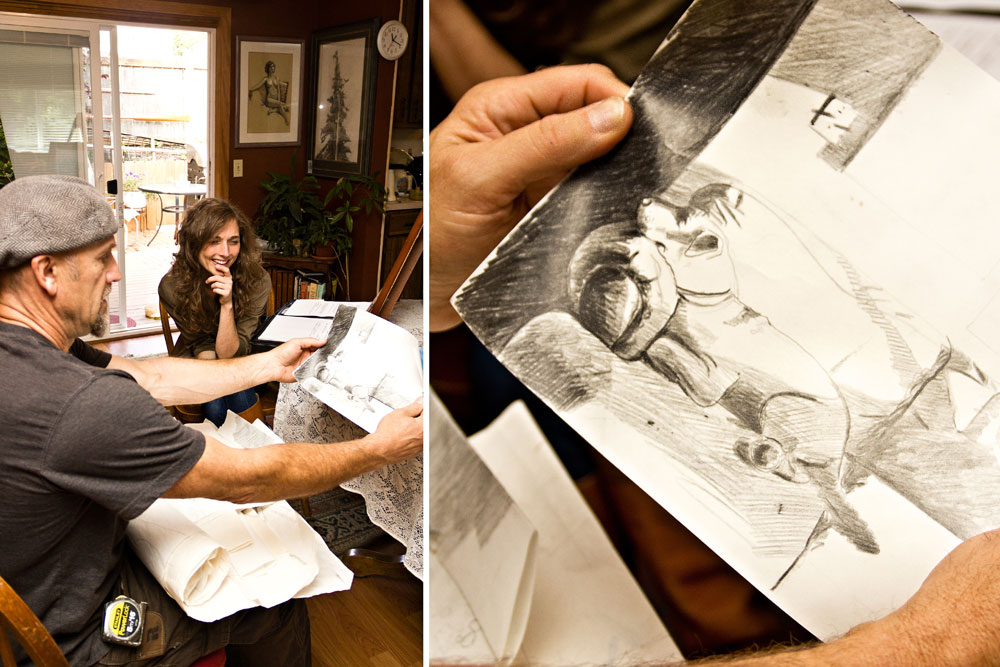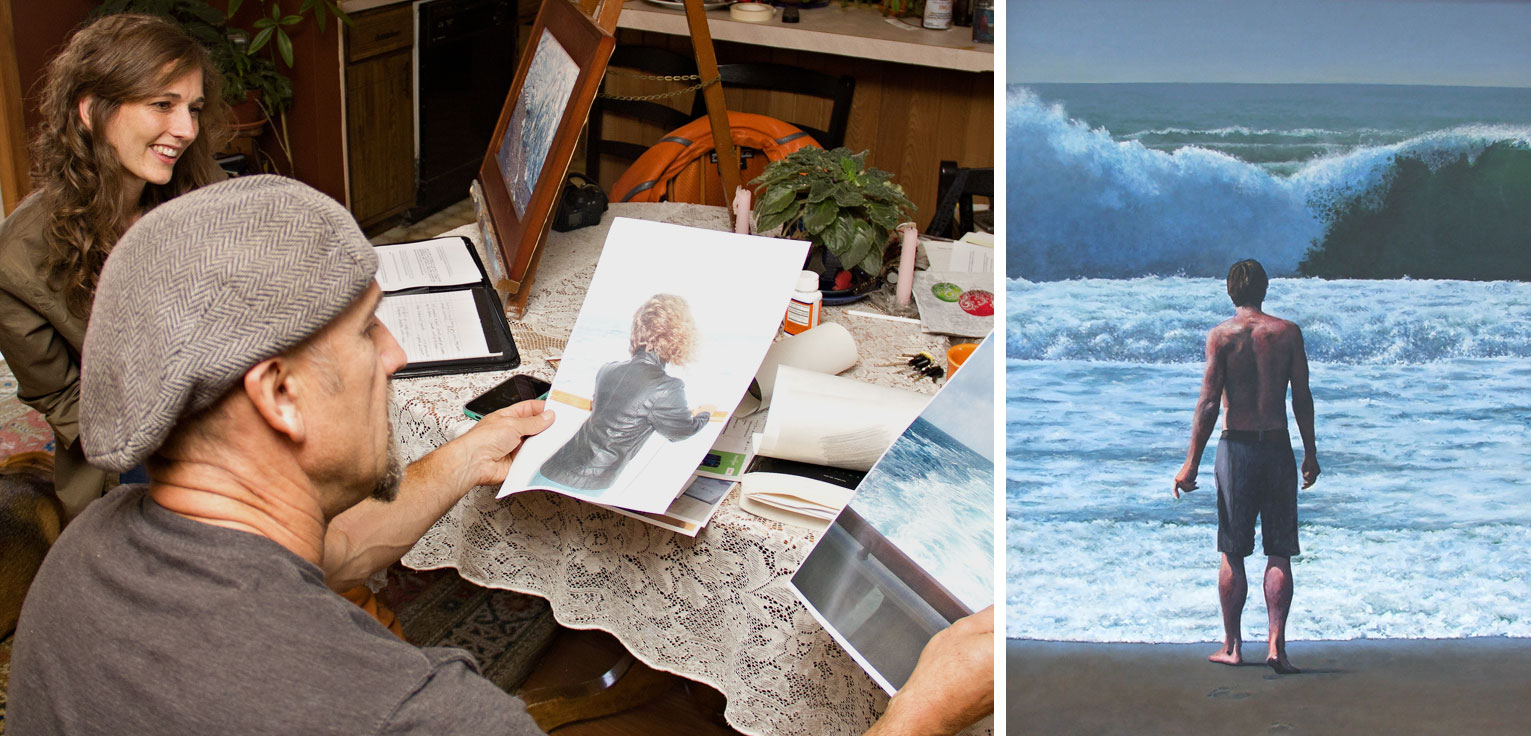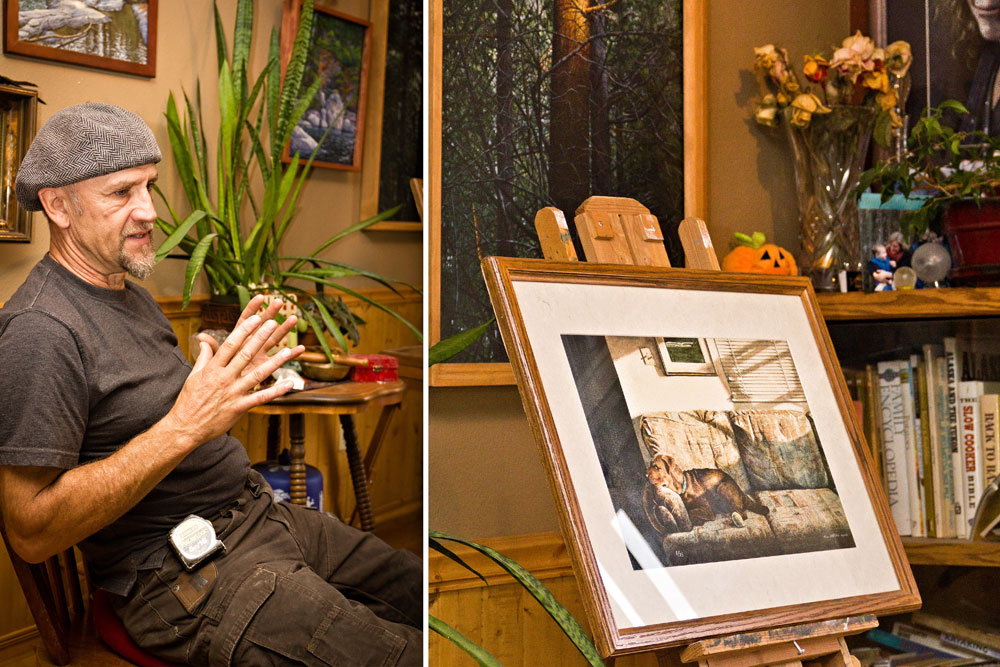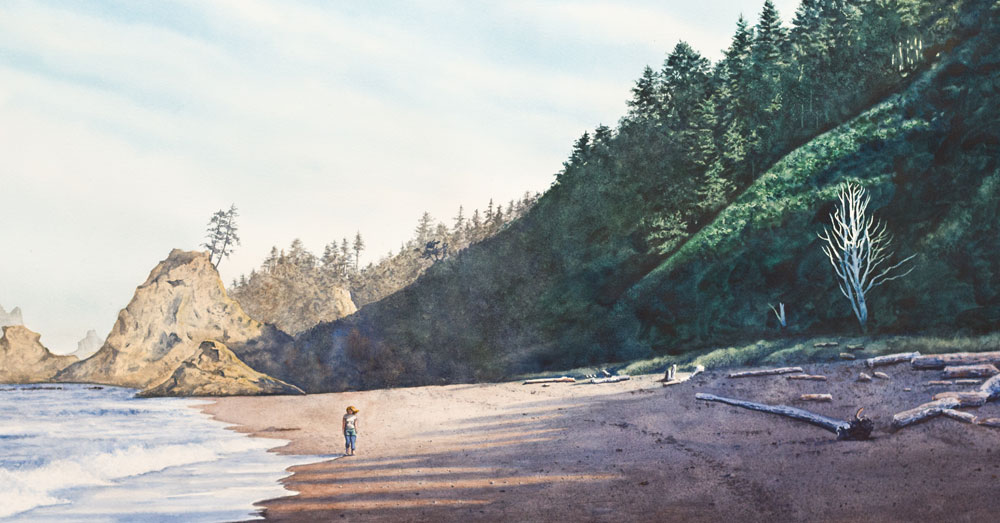Interview with Ron Pattern
While Bellingham Review publishes quality literary work from across the continent, our featured visual artist for the Fall 2014 online edition lives right here in our rainy bay town. In each of his paintings, Ron Pattern honors a locale or scene we know well. It is our pleasure to share his art in this issue so that you, far-flung readers, can picture our place. Pattern is a signature member of the Northwest Watercolor Society and an associate with the National Watercolor Society. He calls his paintings a “visual diary” of his life. Ellie Rogers, Bellingham Review’s assistant managing editor, met with Pattern at his home in Bellingham to learn more about how he translates his days to canvas. Kaitlyn Teer, managing editor, took photos.
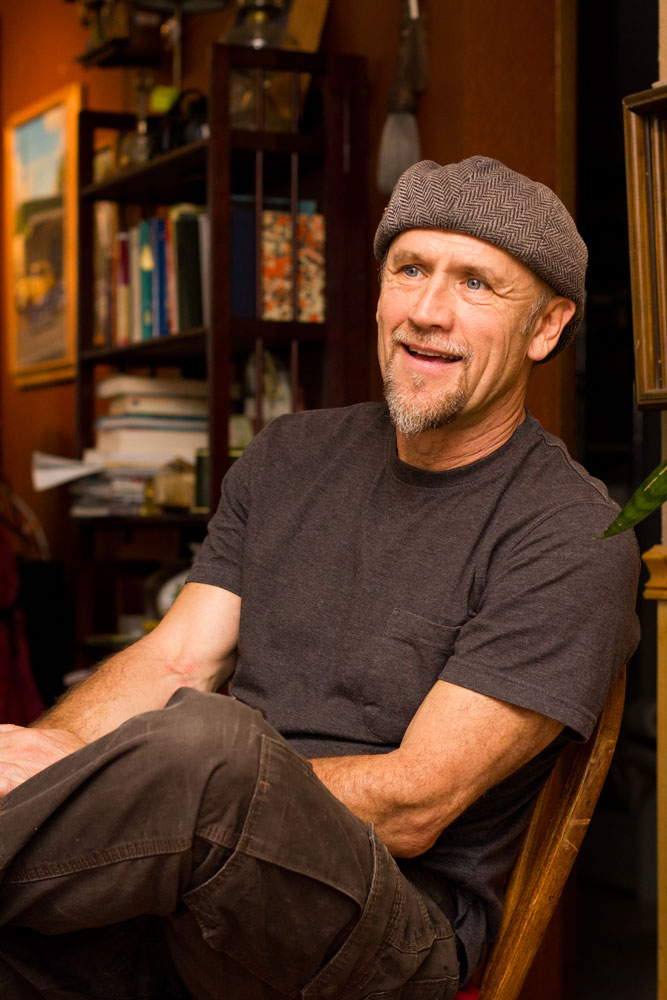 ER: Your work centers around place. Your paintings showcase cedars, ferns, waterfalls, glaciers. Can you talk a little bit about your relationship to the Pacific Northwest and specifically to Bellingham? What’s your connection to this landscape?
ER: Your work centers around place. Your paintings showcase cedars, ferns, waterfalls, glaciers. Can you talk a little bit about your relationship to the Pacific Northwest and specifically to Bellingham? What’s your connection to this landscape?
RP: I think my painting is a way of finding my place. I experience these visual images and they leave powerful impressions on me, so I record them with paint. It’s all local stuff; it’s my dog; it’s Galbraith Mountain, Chuckanut Bay. It’s such a powerful landscape.
I moved away some years back. I lived six years in Colorado, and I just stopped painting. When I moved back here, I started painting again. I just didn’t feel compelled to paint in Colorado. Maybe because I was born and raised in the Northwest. It’s part of me. My palette is all Northwest blues and greens and grays. I’m kind of stuck here.
ER: Well we’re glad you’re stuck here. I also live in Bellingham, and I have to say it is so satisfying to see your work and be able to recognize its subjects as not only from the Pacific Northwest, but from specific locations—Lake Padden or Whatcom Falls, for example—to be able to identify place even without looking at the titles.
Your paintings tend toward recognizable depictions, or realism, and yet they also have a distinct tone and style to them. I wonder if you could tell us how you got started as an artist, as well as speak to the development of your style.
RP: Ever since I can remember I drew and painted. I just felt compelled to do that. In this climate especially, with those long dark, rainy winters, I can remember sitting around the kitchen table with siblings and cousins on a rainy Saturday and we’d draw. I was always compelled to try to be a better painter. I wanted to get to a certain level where I could capture this stuff that left these strong impressions.
I was born and raised in Canada, just north of the border here, so it’s a similar landscape. I went to college and studied art, and then after that, I determined that I was going to be a painter. I was infatuated with Andrew Wyeth, Winslow Homer. I was going to name my son Wyeth, but his mother would have nothing to do with that. I just started studying and painting and painting and painting, and throwing it away and throwing it away, and eventually a few were pretty good. I just stuck to it. They say if you put your 10,000 hours into something you’re going to get good at it.
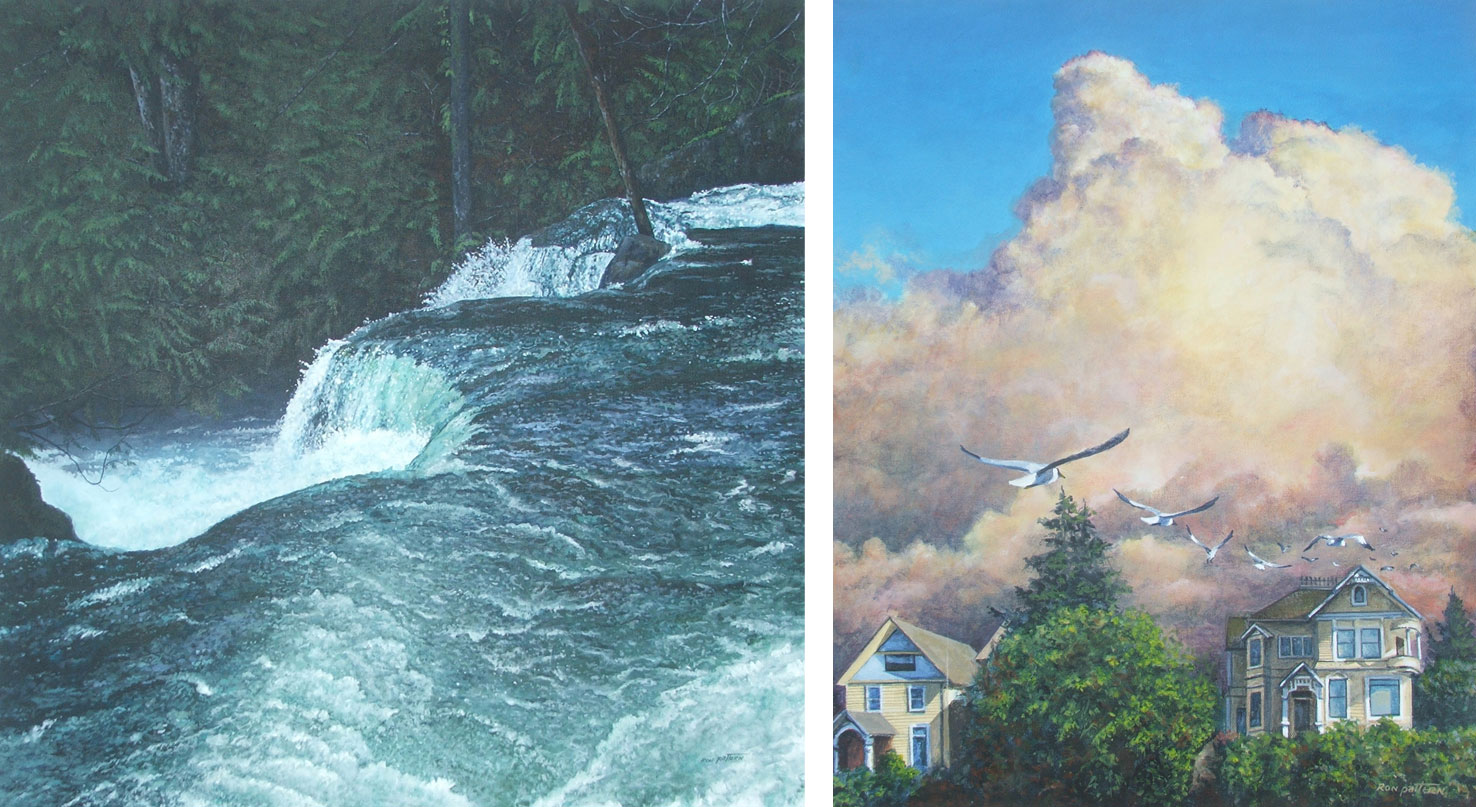
ER: I’m curious about how you choose which subject to take on next and what kind of study you do of each subject?
RP: I haven’t really been painting for the last six months. I’m taking a bit of a sabbatical, so now I’m getting pretty primed to get my studio set up and start painting again.
Generally, I’ll see images that leave these strong impressions, and then I’ll take a lot of photographs. Then I’ll do a lot of sketches. I’ll work out composition. I do a lot of value studies, basically black and white. I also have to build the image in my mind. When I’ve painted it in my head, it’s already done. Then I just have to go through the process of actually doing it. But when it’s solid up there, then it’s kind of done. And then as I’m doing the current painting, the next one starts.
I always do pretty detailed studies. I keep them too. (Pattern heads to his studio and returns to the kitchen table with rolls of sketches.)
Some of these are really old. Like this sketch of my dog, that’s where the painting “Saturday Morning” came from. She was actually lying on that couch right there and the morning sun was falling across and I came out and I saw it and I thought, “Wow, that’s a painting.” So I quickly sketched it and I took some photo references, and there she is.
I took an Alaskan cruise recently with my fiancé Nancy, and I started becoming really fascinated by the water and the sky behind these ships. So I started taking pictures and forming this image. That image of Nancy looking out over turbulent water and sky could create a real emotional impact for a person. People will look at that in a painting and ask, “What’s she doing there, what’s she looking at? What’s she thinking?”
That’s what you try to do as a visual artist, you try to create that emotional impact where people look at it and say, “Oh wow.”
ER: The composition of this photograph reminds me a little bit of The Wave that will appear in the Bellingham Review.
RP: That piece is of my son. My son had some medical issues, some seizures, and he broke his back in the seizures. For me, part of working that out was to do a really detailed painting of him from the back, painting his back, tentatively stepping toward this big, tsunami wave. It must have created emotional impact, because I hung it up at St. Joseph’s Hospital and it sold right away. That’s the shame, the good ones always go.
When that one sold, I kinda went, “Oh.” But it meant something to somebody. Somebody saw it, and they wanted to possess it. That’s important too because it’s out there now. And the energy is out there. That’s a good thing, but I do miss it.
ER: You mentioned earlier that you’re creating a visual record of your life. Andrew Wyeth also said “I paint my life.” I wonder what draws you to chronicle specific, concrete places and people?
RP: Well, like Andrew Wyeth said, he doesn’t travel. He paints Chadds Ford, where he lives. He paints his neighbors. That’s kind of what I do. I paint what’s important to me, what I experience. He said that he could never leave his backyard and he’d never run out of stuff to paint because it’s all about the way the light hits something, or something like that. That’s my philosophy.
ER: I’m really drawn to that. It reminds me of Thoreau traveling “a good deal in Concord.” In Walden, Thoreau walks the miles around his home and finds plenty of intrigue within that radius. To me, that speaks to an ethos very much like Wyeth’s. What drew you to Wyeth originally?
RP: The spiritual quality. His paintings, to me, are just pure magic, the way he captures those moments. You can look at a painting from afar and just be drawn right into it. I went down to the Wyeth display at SAM several years ago, which only had five paintings, but I spent all day there. I’d look and I’d look, then I’d go away and come back and try to process the information. It’s indefinable.
ER: He has a painting of a dog on a bed with the light coming through the window. Your dog painting reminds me of Wyeth’s Master Bedroom. Do you know the one?
RP: Oh yeah, I know it well. That’s a watercolor painting. Primarily, up until three or four years ago I painted watercolor.
ER: And you’re moving into acrylic now?
RP: I’m painting more acrylic now. I think I will probably go back and forth. Watercolor has to be framed behind glass. Watercolor is the medium I really worked hard at getting to know and getting technically good at. Andrew Wyeth employed the drybrush technique in his paintings. He called it a weaving process, weaving pigment over the top of pigment. Since watercolor is so incredibly transparent, it all comes through.
A lot of my new paintings are quite a bit bigger and it’s hard to paint watercolor large. This is probably the biggest piece that I’ve ever painted. It’s technically a landscape watercolor on paper. One thing that’s really hard to do in painting—are you guys painters at all?
ER: We’re writers.
RP: So basically you drink more than painters?
ER: Right. (laughs)
RP: Just kidding. In a landscape painting, it’s hard to get the detail in the shadows. This painting is primarily in the shadow, and the detail is in the shadow. This is my daughter at Shi Shi Beach. I called this painting Wide World because she’s 16, ready to head off into her life. The tide is touching her feet and the shadows are reaching for her but she’s in the light, and that white tree? That’s me. Trees are very metaphorical. I’m kind of off looking at her from the shadow.
That’s probably the last watercolor painting I did, and then I started painting bigger and bigger, so I wanted to use a different medium where I could paint larger. You get a lot of those drybrush issues in there. Wyeth was a master of the drybrush. You take the brush, squeeze the water out of it and let the texture of the paper pick up the pigment. It’s a really difficult process to master. The drybrush technique gives the illusion of detail, time, effort, but really you’re doing broad strokes. I probably spent 15-16 hours on that painting of my daughter.
ER: Do you work in large segments of time or little moments?
RP: Little moments. I do have another job, so I try to get large segments of time on the weekend—four or five hours of studio time—but the rest of the time it’s just a half-hour here, half-hour there.
ER: Sounds familiar.
RP: That makes it hard to chronicle the time. But you learn to be efficient. Probably as a writer you have the same experience. You’ve got to be efficient with your time. You approach your work with a bit more of a workmanlike ethos. Some painters, they’ll go in and they’ll fiddle. When I sit down to paint, I really paint.
ER: It sounds like you’ve been away from painting for a while but now you’re heading back into it. What are you excited to tackle next? What will you be up to? Any new developments?
RP: I’m hoping things are going to change a little bit. Usually when I take a little sabbatical, when I get back to it, my work grows. It’s been a really eventful year—I met my fiancé and my lifelong friend passed away.
You know how sometimes your life goes on year after year? Everything is just clicking along and nothing really changes, and then all of a sudden bam! Everything changes!
ER: Yes! I find that the creative process evolves then too.
RP: Everything gets topsy-turvy. I think my motivation for quite a few years prior to this was more commercial. What do people want to buy? I think that served me pretty well because I had some successful years of sales and commissions. But I think now I’m kind of getting away from that and I’m going to pursue painting that’s important to me, not so much the commercial market. I think I’m going to do more portrait work, employing people in situations and landscapes. I want to just see where that goes.
ER: Do you ever collaborate with your fiancé, Nancy Canyon?
RP: We haven’t, although I think we greatly affect each other’s work. She’s greatly affected my work, I know that. Probably more her writing than her painting. Her poetry is very visual, I think because she’s a painter and a writer. Her painting is very literal, and her writing is very visual. So when I read her poetry especially I get visual images. She’s an amazing poet.
ER: She is! Maybe we can look forward to some ekphrastic work then. Thanks so much for this conversation, Ron. Is there anything else you want to say about your pieces in the Bellingham Review?
RP: The most current painting is the image of my son walking into the wave. Future work is going to be more along that line, searching more for that emotional impact where people really look at an image and feel it. My paintings are becoming a little more story-like. I get an idea and I search out reference, and I’m thinking more as I’m painting that I’m painting a story.
View more of Ron Pattern’s work on his website: patternart.net. Pattern’s next show, “Places & Things,” opens November 7th at Allied Arts in Bellingham, WA.
ELLIE ROGERS is currently studying poetry in the MFA Creative Writing program at Western Washington University. She is the assistant managing editor of Bellingham Review. Her poems appear in Crab Creek Review, Floating Bridge Review, and Midwestern Gothic. Visit her website at elliearogers.wordpress.com.
